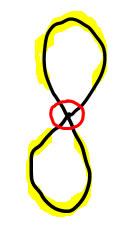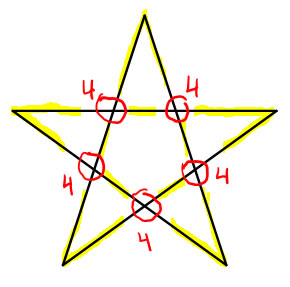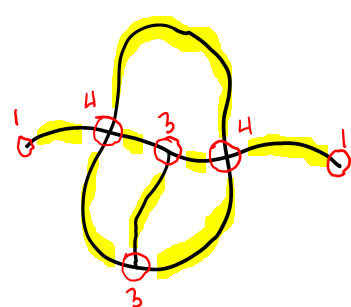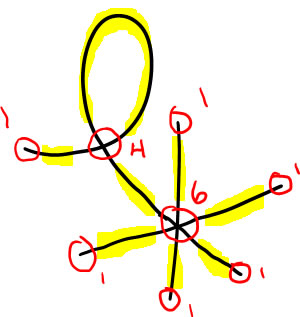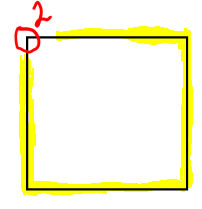2-page printable
Practice problems of the Smiley-Face Type. For each of these problems, the smiley is moving across the "tape-me-here" line in the direction shown by the dashed arrow. For each problem, show what the smiley will look like when s/he reappears on the other side of the "tape-me-here" line. Use the two smileys to determine whether the surface is orientable or non-orientable.
1.
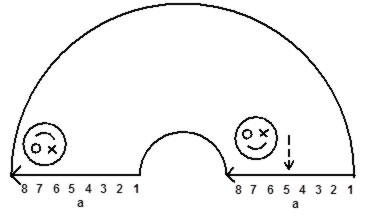
A great idea occurred to my while I was explaining this to one of your classmates yesterday--why not put a number line on the tape-lines? It works great! Just make sure you're always numbering in the same direction: I'm numbering with 1 at the tail end of the arrow, and the last number at the point end of the arrow. So--first notice that the smile goes out first, so it also comes back in first (smile on top). Next, notice that the X lines up with the 6, and the O lines up with the 8--that tells you where to draw the X and O on the new smiley. The old smiley has his left eye closed, and the new smiley has his right eye closed, so this shape is non-orientable.
|
2.
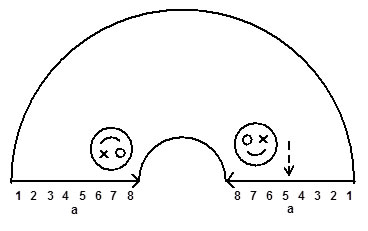
Same deal with the number line. Smile out first, so smile in first (smile on top). X over 6, O over 8. Both smileys have their left eye closed, so it's orientable. |
3.
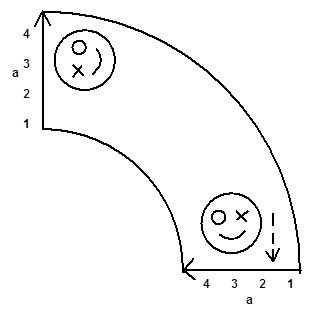
Smile out first, so smile in first, so smile on right. X at 3, and O at 4, so that tells you how to draw the new smiley. The old smiley has his left eye closed, and the new smiley has his right eye closed, the taped shape is non-orientable.
|
4.
If you did the practice problems on Friday, you should go back to the problems--this problem was changed.
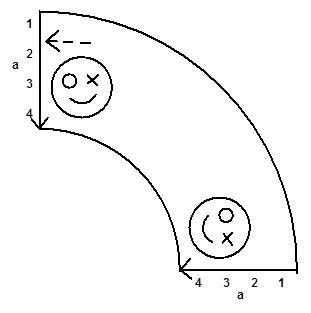
The side of the smiley is going out first, so the side of the smiley will come in first. The old smile was at about 3.5, so the new smile is at about 3.5. The O eye went out first, so it comes in first, so the O eye is on top. Both smileys are winking their left eye, so it's orientable.
|
Moebius strip problems:
5. Explain what it means to say that a Moebius strip has only one side. It means that if you are an ant wandering around on a flat side of the Moebius strip, you can get to every flat spot on the strip without ever climbing over an edge. Before you tape together a strip of paper to make a Moebius strip, the paper has two sides--it it was made of origami paper, one side would be white and the other side colored. When you tape the two ends together, you put in a half-twist so the colored and the white sides are lined up with each other when you tape. That means an ant on the blue side could get to the white side by walking across the tape, and it would never have to climb over an edge to see everything, That means the two sides of the paper strip before taping are really the same side when you put it together into a Moebius band.
6. Explain what it means to say that a Moebius strip has only one edge. It means that if you start at a place on the edge of the Moebius strip, and you mark (color) that edge, and you keep following it around until you get back to where you started, you will find that all of the edge-places on the Moebius strip were colored, and there are no edge-points left uncolored.
Turn me into a vertex-edge graph problem: For each of these line designs, turn it into a vertex-edge graph using as few vertices and as few edges as you can. Draw on the line design to show where each of the vertices should be. Next to each vertex, write the number telling how many edge-ends meet at that vertex.
I also have highlighted so you can see each of the edges. Partial credit would be given to a set of edges and vertices that satisfy the edge conditons, but where you have more than you need. Little or no credit would be given to something that didn't satisfy the edge conditions.
The edge conditions are: no edge crosses itself or another edge and every edge begins and ends at a vertex.
11. Draw a graph that has only 1 vertex, and has more than 1 edge.
There are several possible, mine is a figure 8. It has 1 vertex and 2 edges.
